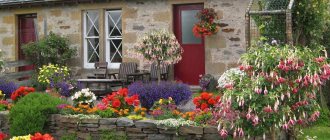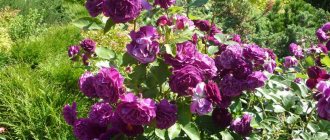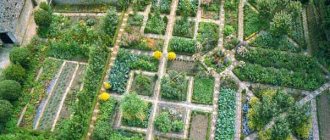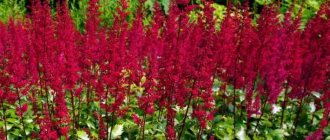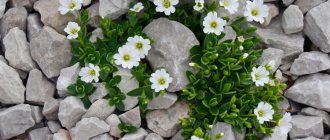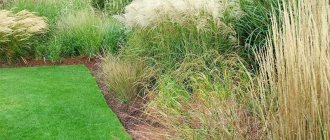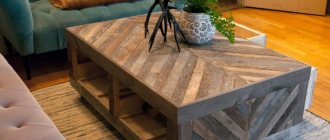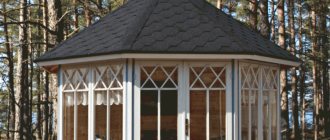Front garden decoration
Landscaping in front of the house includes the arrangement of a front garden. To make everything look neat, first design a path from the gate to the entrance doors; it is a key aspect of the design. The path can be made of concrete slabs, decorative or natural stone, clinker brick, pebbles and wood. If desired, install curbs to prevent soil erosion.
Rows of selected flowers and shrubs are planted along the path leading to the entrance.
As for the plants themselves, preference should be given to various small shrubs. They can be shaped like a ball or any other shape. It is advisable to dilute the space with perennial low-growing flowers that require a minimum of care.
What trees to plant along the fence
Trees for planting on the outside of the fence
Trees on the outside of the street, in addition to their aesthetic function, act as a kind of filter that traps street dust and exhaust gases. For the outside of the fence, trees that can withstand pruning well and are not too valuable or rare are suitable, this will help avoid vandalism. In addition, you need to choose plants that are unpretentious and resistant to frost, drought and other unfavorable conditions. The following are most suitable for these purposes:
- small-leaved elm
- common elm
- Rowan
- river maple
- Tatarian maple
Common elm
In the wild, the common elm is distributed almost everywhere in deciduous forests. It is found in the European part, in Siberia, the Caucasus, and the Baltic states. In Kazakhstan. The tree grows up to 25 meters in height. The plant is shade-tolerant and drought-resistant.
Elm has been used in landscaping for a very long time, due to the fact that it not only tolerates shearing well, but also holds its given shape well. Has many decorative forms:
- silver-motley
- golden-variegated
- red
The disadvantages of elm plantings include their demands on soil fertility. On poor soils, the growth of these trees slows down. In addition, elms can attract unwanted pests and be actively damaged by them. An undoubted advantage is that the common elm lives for a very long time, up to 200-300 years.
Conifers for the inside of the fence
On the inside of the fence, you can plant primarily coniferous trees with slow growth and with decorative needles and crown. In addition to being decorative, coniferous trees purify the air and emit phytoncides that are beneficial to health. In the summer, bright annual flowers can be planted near the plantings to create a contrast with the dark needles.
Suitable for planting near the fence on the inside:
- low-growing species of prickly spruce
- medium-sized species of common spruce
- decorative types of spruce
Norway spruce Acrocona
This species grows no more than 8 cm per year, an adult plant is no more than 3.0 m in height. The crown is conical, with a wide base up to 4.0 m. needles of rich green color. Young pink cones make the trees elegant and attractive. This species does not tolerate dry soils with high salinity.
In addition to spruce trees, low-growing thujas and pines can be grown along the fence. larches. Despite the variety of species and varieties of coniferous and deciduous trees, most property owners when decorating fences give preference to unpretentious shrubs.
Street flower beds
The best option for constructing flower beds under a fence on the street is to use a low plastic, wooden or stone fence. The delimitation of space creates a positive emotional mood, the location of the flower garden in a limited private space, and not on a street, ownerless area.
Design option for a street flower garden
It has been noticed that the creation of such a psychological illusion can be created even by a primitive border made of bricks stuck into the ground or metal circles made of bent rods. The further flight of imagination of the creator depends not only on the type of fence, but also on the distance from the roadway (plants do not tolerate air filled with exhaust gases and require special selection).
Optimal flower bed width depending on the height of the fence
Typically, the choice of plants on the street part depends not only on the boundaries of the space that the owner can use, depending on the width of the sidewalk and the distance of the pedestrian passage from the fence. The distance from the water source is also important. If watering plants is difficult, try to choose unpretentious and drought-resistant crops.
Zoning
Dividing the garden into sectors is a fundamental point. The fertility of the crops grown depends on the successful choice of location for the beds. Accordingly, economic efficiency increases, because vegetables and fruits from the dacha are stocked for almost the whole year. And it’s just nice when efforts in the garden bring good results.
The three pillars on which fruitful gardening is built are the terrain, the composition of the soil and its moisture.
Relief of the site
Not all elevation changes; the slopes are suitable for vegetable growing, growing fruit crops and growing flowers. You should not plant a garden or vegetable garden in lowlands or hollows, especially narrow and extended ones. The temperature in them is always lower due to stagnation of cold air, and the soil is too wet. In such an area, plants will die from frost or rot.
Every 100 meters upward results in a decrease in the average annual temperature by half a degree or a degree. This seems like an insignificant difference, but for some plants it can be disastrous during the first frost.
For most plantings, the best option is a not very flat, but not entirely level area with an orientation to the southwest and southeast. The lower part of such an area will be wetter, shady and cooler. It is more suitable for shade-loving plants that require a lot of moisture.
As you rise, the land will become drier and the temperature higher. The very top will warm up in the sun faster and more efficiently. In increasing order, it is convenient to plant vegetable and berry crops in accordance with their needs for sun and water.
Climate of the region
In the north-west of the country, the most suitable slope for an orchard is considered to be one with a southern side, sloping more towards the west than towards the east. On the Ural and Siberian slopes, on the contrary, you need to choose the eastern side for protection from the harsh climate. Southern, mountainous regions in any area have the same problem - lack of moisture. A flat area or a gentle slope with an irrigation system is optimal.
Soil and subsoil composition
Choosing a suitable environment for the development of the plant root system is a job for a specialist.
Fortunately for gardeners, soil type is not a death sentence. Fertilizing, plowing or forming a new layer of black soil today are available services that are often used by owners of private gardens.
Good soil is permeable to water and air - it has a loose structure. Suitable for growing crops: slightly podzolic, loamy, sandy loam, gray soil compositions. Gardens are also easily created in the forest-steppe, with brown, chestnut and black composition.
Soil moisture level
It is directly influenced by the presence of groundwater. They usually feed plants, but if they are too close to the root system, they cool the soil, saturate it with sulfates and create unfavorable conditions for growth. The distance of groundwater from the root system should be at least 2 meters.
The distance from the surface of the earth is considered depending on the species, plant variety and rootstock. For example, for apple trees on a dwarf rootstock - 1-1.2 m, and for another rootstock, at least one and a half meters is required.
If you already have a country house and green spaces, for redesigning the garden you need to choose places based on the relationships between objects and plants. For example, for light-loving plants, it is important to plant a front garden in front of the house. And behind the home, in the shade of the walls, shade-loving crops will feel good.
You can also plant low shrubs in front of the house, focusing their height on the window frames. Bushes and trees can be placed around the perimeter, vegetable crops - in the center of the site. Vegetables such as pumpkin, zucchini, and cabbage like to change their place of “residence” in the beds from time to time.
Zoning of a personal plot
The hedge does not have to be placed along the perimeter of the site, because it can be used to zone the space, dividing the garden plot into functional zones. This type of territory planning will make the site more spectacular and attractive, convenient and comfortable. Dense walls made of trees provide excellent protection from the sun, creating the opportunity to create a recreation area. Also, green spaces can be used to highlight a playground, which children will not be able to leave on their own if they get lost in the area.
The benefits of a variety of crafts for the garden
It is impossible to imagine a private home without handmade products. They serve as the calling card of any owner, his desire to improve the area, making it more suitable for comfort on vacation.
Crafts for the garden have a number of advantages. For example:
- It's a great time with family. By involving children, you can instill in them hard work in such a simple and interesting form for them, and also draw imagination from restless kids yourself, which will help diversify the creative process and bring something new to products.
- In addition, you can use those available means that will not hurt your pocket. Craft material:
- tree;
- laser discs;
- car tires;
- Styrofoam;
- concrete;
- plastic bottles;
- stone and many more etc.
- A craft made with your own hands will give you confidence in your abilities and a special joy from relaxation, and at the same time the dacha will look much more attractive.
Well, the most important thing is that you can make it quickly and without much effort. You will even need a tool that is in every home
It’s very easy to choose a craft that’s suitable for your project; the photos of the products located on this site will help you with this.
Popular articles Description and cultivation of hydrangea Strawberry Blossom
Peculiarities
To create a landscape design around your country house, you can invite a professional who will draw up a project for you and, after approval, will begin the actual work. This option is suitable for wealthy and busy people who do not like to work on the land and rely on the opinion of professionals in matters of design and style.
Nowadays, all landscape tricks can be learned online completely free of charge.
There is another way to save money: you can purchase very young plants. In this case, it is worth considering that it will take time for them to grow and become stronger. You will not see the final result immediately, but only after a few years, but such an investment in the future will keep your wallet in the present.
When purchasing young plants, keep in mind that as they grow, they will need more and more space. Before purchasing such a seedling, study information about what an adult plant looks like and what parameters it reaches. When planting, give each young seedling enough space to mature.
Competent landscape design not only creates a cozy place to spend time in nature, but also helps solve many issues of imperfect terrain and the size of the site. Thus, a certain order of planting flowers, shrubs and trees will help to visually enlarge the yard area, and the harmonious organization of the entrance area can declare your hospitality and prepare you to welcome guests in the house itself.
Mixborder, border and ridge
These are the most popular options for flower beds that are planted along the fence. Each flower bed has its own characteristics.
In wide flower beds, plants are planted in layers
The closer to the fence, the higher the plants should be, the farther - the lower
Mixborder
A mixborder is a “team” of a wide variety of plants. It includes both annual and perennial crops, tall and short, flowers, shrubs and trees. It is believed that such a flower garden should only be planted near a fence or against the wall of a house, but, in fact, this is not important. It looks impressive against the background of trees, or on the border with a neighboring plot.
The correct selection of plants for a mixborder will ensure its decorative effect throughout the warm season
The main rule: to make the mixborder beautiful and harmonize with the landscape, plants are planted strictly according to their height. From the shortest herbaceous crops, to medium-sized species, and then to shrubs or trees.
In addition, the choice of flowering periods is very important. So that each tier contains crops that bloom at different times of the year. And then the mixborder will be beautiful all season.
Mixborder along a blind fence with western thujas in the background
The most spectacular is considered to be a mixborder against the background of coniferous plants: spruce, pine. Then it is definitely recommended to include boxwood, creeping juniper and dwarf spruce in the overall composition. The result is a harmonious overall picture.
If you plan to plant plants with a strong root system in your mixborder, protect them with border tape, then the roots will be “under control” and other, more sensitive crops will not be harmed. This is perhaps the only limitation when creating a blooming “mix”.
Border and ridge
These types of flower beds, despite their similarity, have significant differences. A border is a low, narrow and dense strip of one or two types of carpet plants. Typically these are crops that are compact. Borders are often used to border paths or lawns. Sometimes they are located around the perimeter.
Border with hostas and daylilies along a wooden fence
Hydrangea border along a concrete fence with stone cladding
The part of the border adjacent to the path is decorated with plants so that they do not overhang the path and do not interfere with movement. The best species for the border are ageratum, sedum, verbena, and low-growing marigolds.
Rabatki are very similar to borders, but they are wider and brighter in color. Their width varies from one meter to one and a half meters, but the length is arbitrary. To make the flower bed look more impressive, it is recommended to make the ridge that is too long intermittent. The ridges can be either one-sided (located on one side of the track) or double-sided (on both sides of the track).
Flower bed with perennial flowers along a white ranch style fence
Luxurious flower garden in English style along a brick fence
As a rule, creating a complex design is not required for an effective design. On the contrary, this “long flower bed” is either made up of three parallel multi-colored stripes, or the simplest design is created.
Flowerbeds along the fence are not only a great opportunity to economically use a suburban area, but also a way to enjoy the variety of flowering plants. Which flowerbed option you choose is up to you to decide. But even the most ordinary flowering plants, planted correctly and given proper care, are guaranteed to please the eye.
Types of shrubs
Which bushes are best to choose so that there are no major difficulties in care? Among the most popular are the following plants:
Variegated varieties of white dogwood are very popular for planting in the garden.
An example of planting turf shrubs near a fence
This shrub is quite common and grows well in the middle zone and Siberia. It is unpretentious, quickly forms a crown, grows well in shady places, tolerates cold winters and even poor ecology. Derain is often used for landscaping in cities. The bush grows up to 2.5 m, the leaves of the derain are broadly ovate. In summer, the bush is decorated with flowers. In autumn the fruits are white. Particularly beautiful are decorative varieties of shrubs with variegated foliage. In addition, the tree crown lends itself perfectly to shaping and cutting.
This shrub comes in a wide variety. With the right combination of different varieties, the bushes along the hedge will bloom from spring to autumn. Spiraea is a shrub of medium height and is 1.5 m. Spiraea fences are dense and grow very quickly. The shrub can be shaped or left to grow freely - the decorative effect does not suffer at all, on the contrary, the flowering will only be more abundant. The plants are unpretentious to the soil, winter-hardy, do not require special watering, and reproduce well by layering.
There are varieties with red or golden leaves that will delight you with beauty all season long. When planting, maintain a distance of at least half a meter.
An unusually beautiful and varied flowering shrub that grows well in temperate climates.
Lilac prefers fertile soil and well-lit places with low groundwater levels. There are also more unpretentious and frost-resistant varieties - Amur and Hungarian lilacs.
The advantage of lilac bushes is their decorative nature and the ability to choose from different varieties. Among the minuses, one can note a great love of light and an active root reproduction system. Without care, the bush grows greatly.
A wild rose hedge looks great and stands up well to pruning. It is especially good to plant it along the fence on the street side. Soon enough you can get an impenetrable thorny shrub that blooms very beautifully in the spring and is decorated with fruits in the summer and fall.
An example of planting rose hips along a country fence
Rose hips reproduce very quickly by root suckers, so for a neat appearance you need to strictly limit the growth of shoots to the sides. To do this, you can use limiters from improvised means: slate, boards, corrugated sheets or specialized garden borders. Rose hips require virtually no care or fertilization. The only thing is that for the first 2-3 years you should water the bushes once a week in hot weather.
Fruit bushes near the fence
You can not only decorate, but also get benefits by planting fruit bushes along the fence, especially if the area is limited by the number of acres. Fruit plantings will require more care if you plan to harvest a rich harvest from them
- Viburnum is a frequently encountered bush, symbolic for the Slavic peoples. Viburnum has a beautiful crown shape and lush inflorescences, which later give way to red berries. Viburnum loves the sunny side and neutral or slightly acidic soils. The bush can grow on infertile soil, but then it will bear fruit poorly.
- Blackberries and raspberries propagate by cuttings and shoots and very soon take over the entire space without care. Raspberries should be limited by digging a border around the perimeter; blackberries, among other things, should not touch the ground - they will sprout.
- Currants spread less well; they are planted in separate holes at a distance of 50-60 cm from each other.
- Cherry will create impenetrable thickets near the fence; its bushes should be thinned from below.
- Chokeberry is an unpretentious shrub with healthy fruits suitable for the harsh climate of Siberia.
The choice of shrubs that can be planted along the fence is quite large.
You should also pay attention to such options as elderberry, barberry, thuja, hydrangea
What can be planted near the fence on the street side?
Flowers are often planted along the fence not only from the side of the house, but also from the street. This will additionally help protect the house from intruders. The ideal option for protection is rose hips, which are planted on the street side. It is unpretentious and produces beautiful flowers. Another great option would be a golden ball - rudbeckia. It produces bright yellow flowers, which is why it got its second name. The height reaches 3 m, blooms from July to late autumn.
What can be planted near the fence on the street side:
- Bright euonymus . This is an excellent option for planting from the outside, as it has unusual fruits. The main advantage is its unpretentiousness, but requires planting in a shady place. To form the crown, annual pruning is necessary.
- Perennial lupine . It is a lush plant with beautiful flowers. It blooms in the second year after planting. It is characterized by rapid growth and a fairly long flowering period. It is best to plant if the fence is solid. This is due to the fact that the plant reproduces quickly, so it can easily enter your area if there is a hole in the fence. The plant loves partial shade.
- Snow-white vangutta . This is a shrub with unusual cascades of flowers, which are often called snow or bride. It blooms in the first half of summer, but sometimes repeats flowering in autumn. Loves the sun, so shade is unacceptable.
Plants Plants
Plants Plants Plants
Many useful articles can be found on our website:
- The most interesting plants in the world - strange, poisonous, beautiful, rare, dangerous: description, photo
- Magical herbs and plants: list, methods of use in magic
- Why is it not recommended to water plants with cold water?
- Rare plants of the Red Book of Russia and the world with names, descriptions and photographs
- What plants, flowers, trees and shrubs bloom in early spring before the leaves bloom: names, list, photos
Initially, the basis of the composition is made up of perennial plants; gaps are made between them, allowing annuals to be planted every year, which can significantly change the appearance of the flowerbed, its filling and color.
Fruit bushes
Why not combine business with pleasure and plant fruit bushes near the fence? This is especially true for small areas.
Kalina. In the summer, the viburnum bush will delight you with very beautiful flowers, which will then be replaced by healthy berries. Viburnum prefers slightly acidic soils and good lighting. If the soil is infertile, the shrub will not grow well.
Blackberries and raspberries. These bushes will delight you with a harvest of berries with virtually no complicated care. There is only one BUT - raspberries and blackberries reproduce very quickly using shoots, so there should be a border along the bushes. Otherwise, the bushes will take over the entire area. Blackberry branches should not touch the ground yet.
Currant . The currant bush takes root quite hard. It is planted in holes at a distance of about 50 centimeters from each other. Currants love frequent loosening and moistening of the soil from below. There is no need to water the leaves. After 15 years the bushes need to be renewed.
Important! Currants love a sufficient amount of light, so the distance between the bushes must be maintained. If the currant grows closely, it will not receive enough light and moisture.
In this case, you should not expect a bountiful harvest.
Chokeberry. This shrub is absolutely unpretentious and does not require special care. Grows well in harsh regions such as Siberia.
Where to start transforming your summer cottage?
Don't start work without a well-thought-out plan
This can be a sketch or diagram, it is important to decide on the main objects
A diagram of a garden plot can be drawn on a sheet of paper.
It is better to divide the entire site into zones, which should be separated by barriers, but well-designed passages and paths should lead to them.
1. Outdoor cooking area. On a site in the yard or garden. This is a barbecue grill, a barbecue, a Russian oven or a paved fire pit with a spit. Away from trees and dead wood, there should be no sparks from the fire. 2. A place for lunch and dinner in the open air. Equipped with garden furniture. This is a gazebo, a covered terrace or an open veranda, an area under a canopy or canopy made of polycarbonate or slate. 3. Water supply, sewerage, drainage, well
They provide circulation and supply of water to the food preparation point, outdoor washbasin, swimming pool, a well-organized irrigation system for the entire area, it is important to consider drainage. 4. Artificial reservoirs. The choice depends on the size of the plot, access to the water supply (well) and the needs of the owners - an inflatable (children's), mobile or stationary pool, fountain pond, waterfall, cascade, etc. It is better to contact specialists; they can do the simplest work themselves
5. Bathhouse, summer shower. The scale of construction depends on seasonality; it is better to build a permanent structure with waterproofing, firebox, drainage and insulation (all-season use). 6. Toilet. It is better to have 2 points - an indoor toilet in the house and an outdoor (street) toilet. It is convenient to equip with a septic tank so that waste does not get into groundwater; the smell is removed with special neutralizers poured into the hole. 7. Summer vacation spots. Swings, benches, gazebos, canopies with upholstered or garden furniture. It is better to do it in the depths of the garden, along paths, under flower arches, opposite green spaces and flower beds, on the lawn. 8. Garden and vegetable garden Many people abandon traditional cultivation in favor of decorative beds and a cultivated garden with landscape design. 9. Green spaces Decorative flower arrangements of various types, hedges, flower beds, gazebos, arches. 10. Garden alleys, paths, paths. A necessary element to unite all objects, their lack is felt after the rain. 11. Children's playground. A sandbox under a canopy is the basis, additions are towers and tents, cars and rockets, sports obstacle courses, stumps and fences with decor.
The playground should be located on level ground and clearly visible
Having distributed the main objects, they plan landscaping, and not vice versa. It is difficult to replant trees and shrubs; large costs will be spent on moving finished buildings. But it makes sense to remove a barn or cellar that is obsolete in order to move it into an extension to the house
It is important to think about where the seedlings will be grown and where to put the greenhouse, if one is needed at all.
A site with a slope must be strengthened with terraces, equipped with steps, bars and cascading galleries made of brick and stone. The masonry can be left “wild” or decorated with cladding. Wood scraps can also be used, but they will not last long.
A stone retaining wall will last for many decades
When organizing leisure facilities, all the wishes of family members are taken into account. The children's playground is located in a place in the garden that is clearly visible from the yard and windows of the dacha. And decorating the garden plot with flowers, figurines and decor is secondary.
- When designing landscape compositions, natural forms are a priority, natural relief, curved shapes are played out, you can make a small pond.
- The wild or Moorish style looks like an abandoned garden or part of the wild, where the porch leads. The design is appropriate if the site faces a lake or river. Then the most “cultivated” one is the courtyard with a lawn and flower mixborders.
The garden begins at the gate
Height of hedge
A green fence can have different heights, so it is important to choose the right plant varieties so that the fence performs the functions and tasks assigned to it by the homeowner. For example, low hedges can highlight flower beds and flower beds and zone the space into functional zones. Plant height is up to 0.7 meters; you can create a low hedge using the following types of vegetation:
- Japanese quince.
- Mock orange "Gnome".
- Holly-leaved mahonia.
- Common heather.
- Alpine willow.
To create a hedge of medium height (1-2 meters), you can use plants that protect the area from the wind and the curious glances of passers-by. These include:
- Elder.
- Tree hydrangea.
- Lilac.
- Spirea.
- Kalina.
If this seems not enough, then you can create a fence whose height will be up to 6 meters. Such a fence will not only hide it from strangers, but will also create shade for certain functional areas. This idea can be realized using the following plants:
- Honeysuckle.
- Bird cherry.
- Berry yew.
- Paniculata hydrangea.
Time to plant trees and shrubs along the fence and paths
In order for the plants to successfully survive the winter period, saturated with low temperatures and powerful winds, when planting, listen to the advice of experts and pay attention to the following points:
1. When planting trees and shrubs, step back from the fence to the distance required for the development of the plant. Otherwise, the roots may destroy the fence, and the crown may shade the neighboring area, causing displeasure to the neighbors. The generally accepted distance from the fence for a tree is 3 m, for a bush it is 1.5 m.
Table of distances between plantings
2. Move large trees at least 5 m away from the fence. They subsequently form a powerful crown and grow significantly higher than the fence.
3. When planting plants, you need to ensure that there are no places with stagnant air on the site. During winter frosts, seedlings in this area may freeze.
4. It is also necessary to retreat about seven meters from the residential building, otherwise the tree may destroy the foundation with its roots.
5. When planting, retreat significant distances from the water supply.
6. Keep trees and shrubs, especially those that produce edible fruits, away from the drainage pit.
The most appropriate time to plant trees and shrubs along the fence and paths is generally considered to be autumn. There is a rule that bushes and trees that bloom in spring are best planted in the ground in the fall. Vegetation takes root well in spring and blooms in late summer.
Shrub planting scheme
Based on these recommendations, it is better to postpone planting until the autumn. This must be done before frost, it is advisable that the plant has time to take root. Most often, plant transplantation is performed in October. If there is a need to do this later, but the frost has not yet set in, you can carry out the work, but provide additional insulation. To do this, add sawdust or peat near the trunk.
Mulching bushes along the fence with sawdust
During frosts, replanting trees and shrubs is not recommended. It is better to simply dig them in in an inclined position, cover the roots with a layer of peat and soil, and plant them in the spring.
Digging seedlings for the winter
When choosing trees and shrubs for planting along the fence and paths, take into account the recommendations given in the article. They will help you properly organize the green space of your suburban area. Receive aesthetic pleasure, relaxation and enjoyment from country life.
Popular articles How to make concrete products for landscape design
Flowers
If you have a beautiful stone, wooden or wrought iron fence, you can highlight it with a lush and colorful flower bed. Plant flowers in one or several rows, in a ladder, as well as in complex decorative compositions.
Roses
Roses are very capricious and require fertile soil, regular watering and fertilizing. They are sensitive to drafts, lack of light and any other external irritants. But if you manage to grow a hedge of roses, your garden will become truly royal.
Rudbeckia
Rudbeckia is often found in areas in our latitudes, but not everyone knows its name. The flower with large yellow inflorescences is popularly called the “golden ball”. Rudbeckias are propagated by regular sowing and look very good in large groups along the fence.
Mallow
Mallow is an unpretentious perennial that pleases with its flowering until mid-autumn. It reproduces easily and does not require complex care throughout the season. Mallow grows very tall, so it is suitable for camouflaging a not very beautiful and neat fence.
Sunflower
Tall and bright sunflowers are not the most obvious choice for decorating an area. But think: they are large, beautiful, unpretentious and stretch 1-1.5 meters towards the sun! Behind such flowers you can easily hide even the most inconspicuous fence in your country house.
Primrose
Primrose is ideal for small decorative flower beds. It amazes with a riot of colors and quickly blooms with the onset of warm weather. While other plants are just waking up after winter, primrose is already pleasing with its delicate beauty. It's also grown as a perennial, so you don't have to re-sow the seeds every spring.
Lavender
Lavender grows in delicate, fragrant clumps and looks great along fences and garden paths. It will immediately fill your plot with the spirit of the French province, but in return it will require a lot of light and abundant watering. Contrary to stereotypes, lavender is not only purple, but also white, pink or blue.
Violets
Violet is wonderful for creating the last layer of multi-layered compositions or for mixed mixboards. Its flowers can be purple, lilac, soft blue or deep burgundy, almost black. Violet loves shaded places, and this will be provided by plants higher along the fence.
Peonies
Peony is another luxurious perennial that you only need to plant once and enjoy its beauty every season. It grows in tall, spreading bushes with large flowers, making it great for planting along a fence. Peonies do not require constant feeding and complex care, despite their amazing decorative properties.
Lily
It is impossible to remain indifferent to the exotic beauty of lilies. A huge variety of varieties are distinguished by the most bizarre colors. But keep in mind that lilies require free space and do not tolerate shading by tall trees. Therefore, it is better to plant them solo along the fence or combine them with low-growing flowers.
Tulips
Bright multi-colored tulips are planted independently only along low borders when creating garden paths and landscape compositions. But they perfectly complement the flowering mixboards along the fence around the site. Choose varieties with different flowering periods - and they will delight you from the first days of spring until summer.
The best varieties of apples: photos, names and descriptions (catalog)
What to consider when disembarking
Before you go shopping for seedlings, think about the following points:
- is your side shady or sunny?
- how much wind blows the area;
- what is the purpose of planting: protection, decoration or shade formation;
- estimated area of landscaping;
- specifics of the dacha layout;
- what is the design of the fence (color, material);
- required planting height;
- depth of groundwater;
- soil type and composition, climatic features of the area;
- type of seedlings (requiring care or unpretentious);
- compatibility of different cultures;
- how long will the selected seedling grow to the desired size.
If the size allows, then planting is carried out in several ranks. Thus, a solid green wall is formed.
https://www.youtube.com/watch?v=36N2T9sKUUc
Low plants (for example, blue spruce) are recommended to be located closer to the road so that they absorb harmful exhaust gases from car fuel.
We must not forget about the rapidly developing root system, which can damage the base of the fence, so the distance from the seedlings to the fence should be from 3 to 5 m. With a smaller value, the roots, as they grow, will lead to cracks in the foundation or a nearby fence will shade the trees.
If you decide to plant plants near your home for the first time, we advise you to consider the following:
- The best time to plant or replant plants is autumn. But it is advisable to complete the work before mid-October, so that the seedling has time to take root before the first cold weather.
- If flowering occurs in the spring, then you need to plant it in the fall; if it blooms at the end of summer, you can start planting in the spring.
- Planting any type of living plants at sub-zero temperatures is impossible.
- If the work was not completed before the end of October, you can try to protect the roots of the seedlings with mulching (peat, sawdust, leaves).
- All flowering and fruiting plants are planted on the sunny side of the site.
- The distance from the road surface should be from 30 to 50 cm.
We invite you to familiarize yourself with the benefits of blueberry jam. What are the benefits of blueberry jam?
Where to begin?
Experts advise planning and placing trees and shrubs along the fence and paths immediately, simultaneously with planning a suburban building. An integrated approach to organizing and filling space will allow the summer cottage site to acquire a lived-in appearance by the end of construction work, be filled with greenery and look like a real kingdom of nature.
Site plan with location of shrubs
Before starting work on landscaping the area, inspect the area, become familiar with its advantages and pay attention to the disadvantages, evaluate the possibilities and conditions for planting
This is very important for choosing varieties and varieties of trees and shrubs
When arranging a suburban area, in order to maintain the harmony of all components and get a complete space, it is better to pay attention and be guided by the recommendations developed by specialists. Before deciding which plantings will grow near the fence, which bushes inside the territory, you need to pay attention to the suburban space and get answers to the following questions: 1
Decide on the purpose of the bushes and trees used for landscaping the area. Figure out what your goal is when planting: to close an ugly fence or to decorate a lovely structure. Choose what main function the plants will serve: to camouflage the fence or harmoniously coexist with it
1. Decide on the purpose of the bushes and trees used for landscaping the site. Figure out what your goal is when planting: to close an ugly fence or to decorate a lovely structure. Choose what main function the plants will serve: to camouflage the fence or to harmoniously coexist with it.
Masking a fence with bushes
2. Determine for yourself what part of the space falls under the control of trees and shrubs, and how much free space it costs to leave. Do not overload the area. Excessive loading of trees and shrubs along the fence, especially tall plants, will visually reduce the area and make it oversaturated.
Shrubs along the paths should not overload the space
3. Determine which side of the fence is available for planting: brightly lit by the sun or constantly in the shade
When planting trees, focus on the shade cast by the fence and plant only those plants that grow well in those shady conditions.
Barberry bushes tolerate shade well
4. What is the soil like in the area of future planting? In order for a plant to truly reveal its decorative properties, it must grow in comfortable conditions.
5. How much subsequent care is expected for the plant?
Is it possible to provide constant attention to the capricious flora, to provide pruning and shaping of trees and shrubs that need it?
Hedges need regular maintenance
There are two options for the formation of vegetation on a personal plot:
1. Landscape planning does not require special human participation. This method of forming a territory is especially suitable for areas located on uneven terrain. In this case, due to the natural difference in levels, the plants look beautiful and together form interesting compositions.
Free landscape planning of the site
2. Geometric layout involves maintaining certain distances between bushes and trees and maintaining strict geometric shapes. Most often, in this case, rows of densely planted trees are created. There is empty space between the rows and lonely vertical plants in the middle of the plot.
Strict geometric layout of the site
Shrubs instead of a fence
A green fence instead of traditional materials is an alternative and very effective solution that will certainly make the site stand out among many. When planting a living bush fence, you should decide on its main purpose:
- Aesthetic. Flowering bushes will perfectly cope with this role: lilac, viburnum, hydrangea, spirea, barberry, jasmine and others. The timing of flowering for plants varies. If you create compositions from different species, you can get a continuously flowering hedge. It is better to select bushes of the same height and the same type of foliage, but with different flower blooming periods. Tall and lush bushes will also cope well with their protective function.
Options for living shrub fencing
Impenetrable and barbed fence. To make it as difficult as possible to enter the area, you can use thorny bushes: rosehip, gooseberry, sloe, hawthorn, tea rose. Evergreen living fence. A fence made of evergreen shrubs will please the eye at all times of the year and will protect the area well. The following bushes are classified as evergreen: heather, Erica, juniper, thuja.
Shrub height
- Low growing bushes. To create a low hedge up to 0.5 m, you can plant the following shrubs: boxwood, alpine currant, yellow acacia, gooseberry, and artisanal cinquefoil.
- Medium-sized bushes. The following shrubs are suitable for a hedge up to 3 m: white derain, hornbeam, thuja, lilac, juniper, rosehip.
- A fence made of tall bushes. The following bushes grow over 3 m: hawthorn, dogwood, yew, western thuja, common hornbeam.
Shrubs can be planted in one or two lines. Most often, one row consists of low or short-cropped shrubs, and the second row consists of tall plants
Of course, such a number of plantings can be planted over a large area. When choosing shrubs for a living fence, the following factors should be taken into account:
An example of planting shrubs in several lines
- combination with other shrubs;
- unpretentiousness;
- flowering period;
- ease of shaping and cutting;
- growth rate.
Caring for a living fence
Without a doubt, a well-groomed hedge at the dacha will become the calling card of any site. Caring for green hedge shrubs involves cutting, watering and fertilizing the plants. Seedlings for a fence should be chosen especially carefully, because all the bushes must grow together for the integrity and beauty of the fence.
Trimming the bushes is especially important - it helps keep the fence in excellent condition, and pruning is also beneficial for the plants.
Trimming a living fence
Like any plants in the garden, a hedge needs care: timely feeding and watering. Even if the crown grows freely, this does not mean that the plants do not need pruning
Thanks to regular pruning, the bushes will be denser and the flowering will be thicker, which is very important for a living fence, no matter whether it is decorated or not
Flowerbeds along different fences
As already noted, the shape of the flower bed near the fence and its content directly depends on the height and type of fence. Let's try to choose options for mesh fencing, picket fences and forged structures.
Flower arrangements planted along the fence may include not only low-growing plants, but also shrubs, fruit trees and climbing vines
Decorating the mesh
Chain-link is considered one of the most popular materials for creating fencing. In order to “beat” such a fence, you do not need to have a special education or purchase expensive crops. Wild grapes, hops or Jerusalem artichokes are planted in flower beds along mesh fences.
You can decorate a mesh fence with annual or perennial climbing plants. The photo shows a living wall made of perennial virgin grapes
Among the annual loaches, morning glory is often chosen, growing in almost any soil and not requiring special care.
Beans or peas look good. And in addition to climbing varieties, a flowerbed of shade-tolerant and low-moisture crops, such as lupins or rudbeckia, is arranged along the fence. Often in this situation, it can be difficult to see the fence itself behind the lush flowering of plants. And that's not a bad thing. The fence ceases to be only a functional element.
Wooden picket fence
Hydrangeas, hollyhocks, decorative sunflowers and vines (actinidia, clematis, grapes) are planted directly along the picket fence. And a little further from the fence, medium-sized or low-growing shade-loving crops are planted.
Pink or blue hydrangea will look good against a white fence
It has become very popular to place fruit bushes along the picket fence. For example, honeysuckle, raspberries or currants. Felt cherry is also quite suitable - a small and very beautifully flowering shrub. And among ornamental shrubs, preference is usually given to lilac or jasmine.
A shady place along the fence can be filled with thujas, alternating with low-growing shrubs and hostas
If we talk about flowers, unpretentious species are often chosen. Marigolds and lobelia are considered suitable for landscape decoration along the fence. Hand-made looks incredibly impressive. Tree logs, dishes that are no longer used in the kitchen, tires and other materials, when in capable hands, turn into works of design art, and the summer cottage becomes unique in its kind.
Color combinations are used in such a way that flowering lasts throughout the season.
Forged metal fence
Since wrought iron fences tend to be rare, these fences provide excellent visibility. And the flowers are chosen in such a way that the flowerbed will be blooming all season. Then the perimeter will look elegant and impressive.
A forged fence looks beautiful, decorated with bright flowers in hanging containers
If the flower bed is wide, then the plants are planted in tiers: the further from the fence, the lower. Suitable crops are boxwood, low-growing thuja, juniper, as well as saxifrage, primrose, and heuchera. And to make a decorative fence inside the site, use bricks or stones.
Thuja occidentalis will decorate the perimeter of the site all year round
In the case where the flowerbed is long and narrow, it is better to use plants of the same type: carnations, asters, lavender, soapwort, etc.

